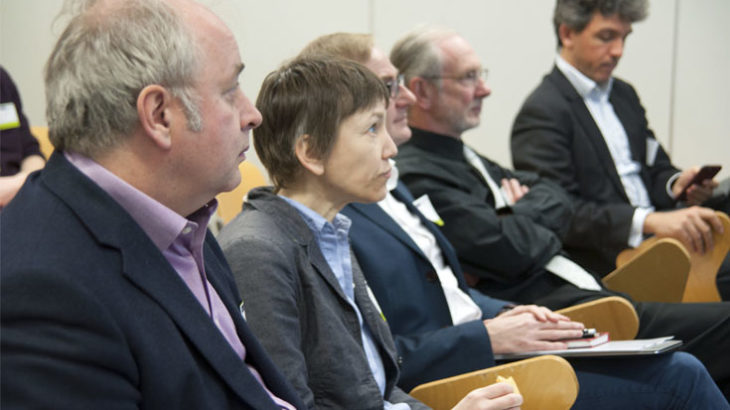Guest Post: ISIS – access the atomic-scale

Beamtime and Batteries at a World-leading Neutron and Muon source
My first interaction with the UK neutron and muon source, ISIS, was to apply for beamtime in November last year (2018).
The experiment: to probe structural changes within battery electrodes whilst they are being cycled, i.e. to watch layers of graphene in disordered carbons “breathe” in response to in situ charging and discharging.
I am at the very beginning of my PhD, so when I was granted beamtime my first reaction was to be both excited and a little intimidated. By attending “ISIS: Access the atomic-scale” at the end of February, I hoped to learn a bit more about how best to harness the facility and make the most of this great opportunity.
The event was held in the sleek Sir Alexander Fleming building at Imperial College London, just around the corner from the Science Museum and opposite the famous Queen’s tower. With a plateful of mango and grapes I took to my seat eagerly, ready to soak up some science.
I knew that the UK had its very own synchrotron particle accelerator facility as part of the Science and Technology Facilities Council, but what I didn’t realise until this event was how the neutron and muon facilities of ISIS set it apart as world leading in its capabilities.
There are some experiments that can be done at the ISIS neutron and muon source in the UK that cannot be done anywhere else in the world. From watching the movement of atoms within materials, to monitoring degradation in aeroplane turbines, to revealing new secrets about the cannonballs on the salvaged Mary Rose ship, the topics of study are as diverse as they are interesting.
The creativity of research discussed in this meeting both inspired and surprised me. For example, I had no idea walking into this that I was going to learn insights into the cream I use to soothe my eczema!
However, one of the main take home messages I took from the speakers and chatting to the instrument scientists and other researchers over coffee, was seeing how approachable, keen and curious the instrument scientists are to work with and support you in collaborative research. This has also been my experience working with and consulting the instrument scientist Dr Thomas Headen in the run up to the experiments I will be performing on the NIMROD instrument in just under a week’s time.
The interaction of neutrons with matter provides complementary studies to the X-ray facilities at Diamond, exemplified in the work on the Mary Rose artefacts, where neutrons allowed the discovery of iron cores inside a lead outer casing which is impenetrable to X-rays.
Similarly, in my PhD research into secondary batteries, the different interactions governing the techniques allow neutrons to see lighter elements that are tricky to study using X-ray, such as lithium or sodium, which are integral to battery materials.
Another take home message was that neutrons are a powerful tool for probing matter at length scales from interatomic to macroscales, as well as a wide range of energies. Nobel prizes have been awarded to scientists utilising neutron studies on at least three separate occasions. This knowledge leaves me feeling incredibly inspired and I am confident that the work will provide great benefit to my doctoral thesis. I hope that it will provide a basis for further beamline experiments, and I am reassured that I have the surrounding support and expertise from the facility to ensure my experiments have the best chance of success.
More from the event
Design-to-Device Approach to Engineering Solar Cells at the Molecular Scale
Head of Molecular Engineering University of Cambridge
Download Presentation
Flexible, Functional Frameworks
Senior Lecturer in Condensed Matter and Materials Physics, Queen Mary University of London
Download Presentation (coming soon)
Revealing the Hidden Structure and Dynamics of Matter: opportunities for research at the ISIS Neutron and Muon source
Diffraction & Materials Division Head ISIS
Download Presentation
Long Nights in Didcot Doing Drugs and Stuff
Reader in Computational & Molecular Biophysics, King’s College London
Download Presentation
Coupling Microfluidics and Scattering for the Molecular Engineering of Soft Matter
Professor of Soft Matter Engineering Imperial College London
Download Presentation (coming soon)

